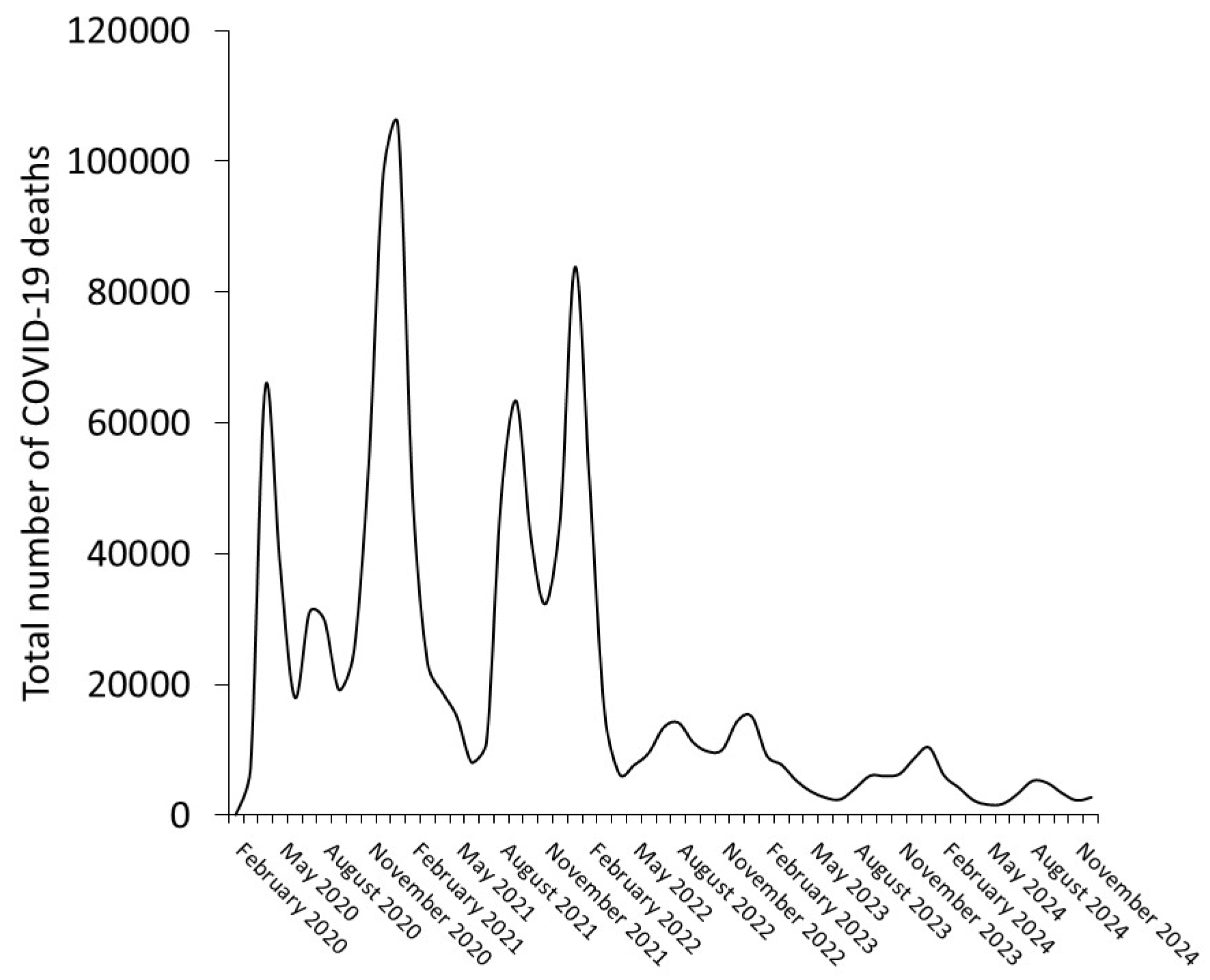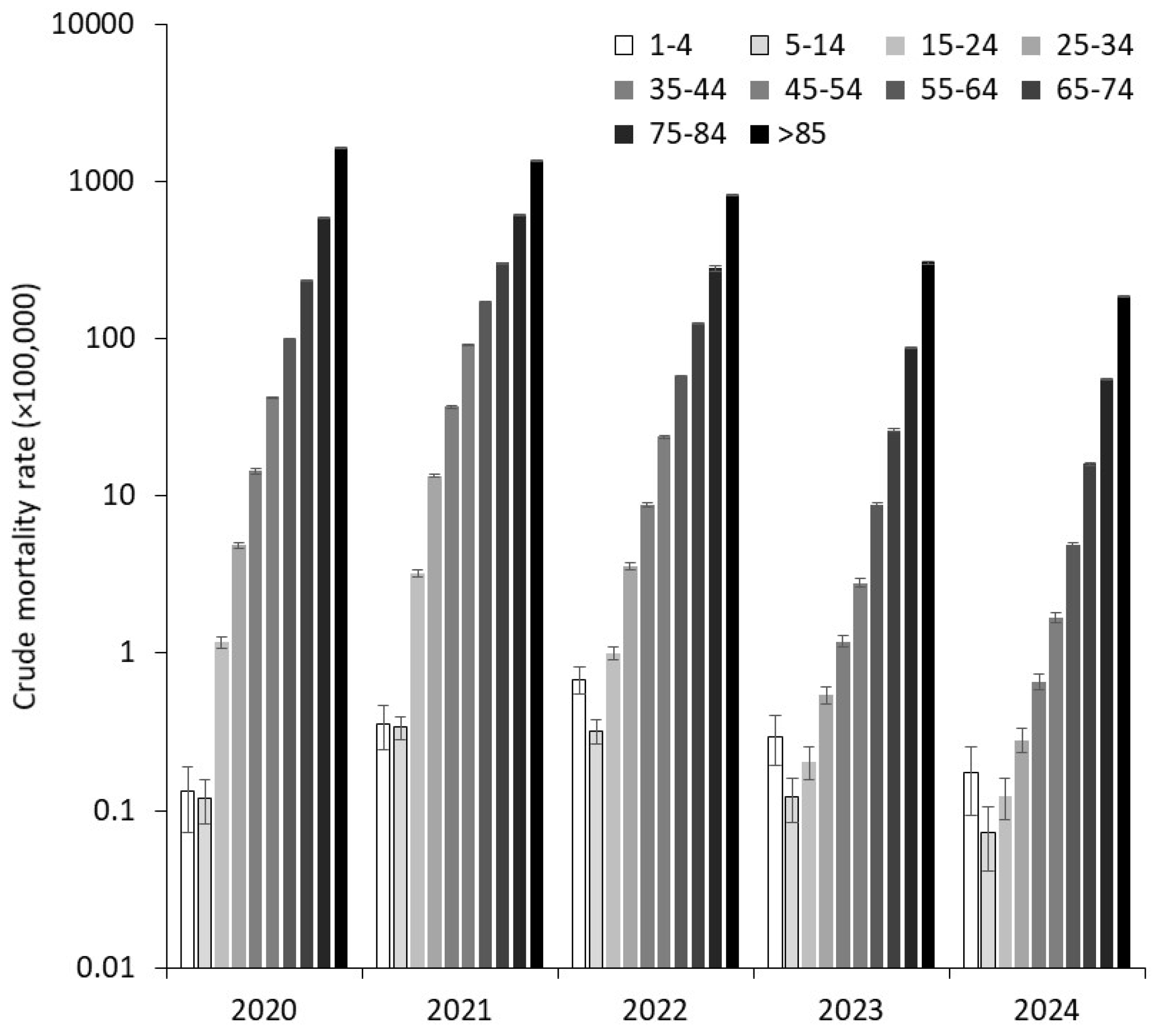COVID-19 Mortality Trends over the First Five Years of the Pandemic in the US
Abstract
1. Introduction
2. Materials and Methods
3. Results
4. Discussion
5. Conclusions
Author Contributions
Funding
Institutional Review Board Statement
Informed Consent Statement
Data Availability Statement
Conflicts of Interest
Abbreviations
| COVID-19 | Coronavirus disease 2019 |
| SARS-CoV-2 | Severe acute respiratory syndrome coronavirus 2 |
| NCHS | National Center for Health Statistics |
| WONDER | Wide-Ranging Online Data for Epidemiologic Research |
| ICD-10 | International Classification of Diseases, 10th Revision |
| ICU | Intensive care unit |
| RSV | Respiratory syncytial virus |
| CISA | Cybersecurity & Infrastructure Security Agency |
References
- Mattiuzzi, C.; Lippi, G. COVID-19: Lessons from the Past to Inform the Future of Healthcare. COVID 2025, 5, 4. [Google Scholar] [CrossRef]
- Hernandez, J.B.R.; Kim, P.Y. Epidemiology Morbidity And Mortality. [Updated 3 October 2022]. In StatPearls; StatPearls Publishing: Treasure Island, FL, USA, 2022. Available online: https://www.ncbi.nlm.nih.gov/books/NBK547668/ (accessed on 13 January 2025).
- Khan, J.R.; Awan, N.; Islam, M.M.; Muurlink, O. Healthcare Capacity, Health Expenditure, and Civil Society as Predictors of COVID-19 Case Fatalities: A Global Analysis. Front. Public Health 2020, 8, 347. [Google Scholar] [CrossRef] [PubMed]
- Yang, F.; Tran, T.N.; Howerton, E.; Boni, M.F.; Servadio, J.L. Benefits of near-universal vaccination and treatment access to manage COVID-19 burden in the United States. BMC Med. 2023, 21, 321. [Google Scholar] [CrossRef]
- Lippi, G.; Henry, B.M.; Plebani, M. A Simple Epidemiologic Model for Predicting Impaired Neutralization of New SARS-CoV-2 Variants. Vaccines 2023, 11, 128. [Google Scholar] [CrossRef]
- Filip, R.; Gheorghita Puscaselu, R.; Anchidin-Norocel, L.; Dimian, M.; Savage, W.K. Global Challenges to Public Health Care Systems during the COVID-19 Pandemic: A Review of Pandemic Measures and Problems. J. Pers. Med. 2022, 12, 1295. [Google Scholar] [CrossRef]
- Cueni, T. Lessons learned from COVID-19 to stop future pandemics. Lancet 2023, 401, 1340. [Google Scholar] [CrossRef]
- Centers for Disease Control and Prevention, National Center for Health Statistics. National Vital Statistics System, Provisional Mortality on CDC WONDER Online Database. Data Are from the Final Multiple Cause of Death Files, 2018–2022, and from Provisional Data for Years 2023–2024, as Compiled from Data Provided by the 57 Vital Statistics Jurisdictions Through the Vital Statistics Cooperative Program. Available online: http://wonder.cdc.gov/mcd-icd10-provisional.html (accessed on 13 January 2025).
- ICD-10-CM Codes. 2025 ICD-10-CM Diagnosis Code U07.1. Available online: https://www.icd10data.com/ICD10CM/Codes/U00-U85/U00-U49/U07-/U07.1 (accessed on 13 January 2025).
- Matthes, K.L.; Staub, K. The Need to Analyse Historical Mortality Data to Understand the Causes of Today’s Health Inequalities. Int. J. Public Health 2024, 69, 1607739. [Google Scholar] [CrossRef]
- Franchi, M.; Pellegrini, G.; Cereda, D.; Bortolan, F.; Leoni, O.; Pavesi, G.; Galli, M.; Valenti, G.; Corrao, G. Natural and vaccine-induced immunity are equivalent for the protection against SARS-CoV-2 infection. J. Infect. Public Health 2023, 16, 1137–1141. [Google Scholar] [CrossRef]
- Tsagkli, P.; Geropeppa, M.; Papadatou, I.; Spoulou, V. Hybrid Immunity against SARS-CoV-2 Variants: A Narrative Review of the Literature. Vaccines 2024, 12, 1051. [Google Scholar] [CrossRef]
- Bhimraj, A.; Morgan, R.L.; Shumaker, A.H.; Baden, L.; Cheng, V.C.C.; Edwards, K.M.; Gallagher, J.C.; Gandhi, R.T.; Muller, W.J.; Nakamura, M.M.; et al. Infectious Diseases Society of America Guidelines on the Treatment and Management of Patients With COVID-19 (September 2022). Clin. Infect. Dis. 2024, 78, e250–e449. [Google Scholar] [CrossRef]
- Livieratos, A.; Gogos, C.; Akinosoglou, K. SARS-CoV-2 Variants and Clinical Outcomes of Special Populations: A Scoping Review of the Literature. Viruses 2024, 16, 1222. [Google Scholar] [CrossRef] [PubMed]
- Bachmann, M.; Gültekin, N.; Stanga, Z.; Fehr, J.S.; Ülgür, I.I.; Schlagenhauf, P. Disparities in response to mRNA SARS-CoV-2 vaccines according to sex and age: A systematic review. New Microbes New Infect. 2024, 63, 101551. [Google Scholar] [CrossRef] [PubMed]
- Ramírez-Soto, M.C.; Ortega-Cáceres, G.; Arroyo-Hernández, H. Sex differences in COVID-19 fatality rate and risk of death: An analysis in 73 countries, 2020–2021. Infez. Med. 2021, 29, 402–407. [Google Scholar] [CrossRef]
- Shahid, Z.; Kalayanamitra, R.; McClafferty, B.; Kepko, D.; Ramgobin, D.; Patel, R.; Aggarwal, C.S.; Vunnam, R.; Sahu, N.; Jain, R.; et al. COVID-19 and Older Adults: What We Know. J. Am. Geriatr. Soc. 2020, 68, 926–929. [Google Scholar] [CrossRef]
- Rossi, A.P.; Gottin, L.; Donadello, K.; Schweiger, V.; Nocini, R.; Taiana, M.; Zamboni, M.; Polati, E. Obesity as a risk factor for unfavourable outcomes in critically ill patients affected by Covid 19. Nutr. Metab. Cardiovasc. Dis. 2021, 31, 762–768. [Google Scholar] [CrossRef]
- Martin, B.; Rao, S.; Bennett, T.D. Disparities in Multisystem Inflammatory Syndrome in Children and COVID-19 Across the Organ Dysfunction Continuum. JAMA Netw. Open 2023, 6, e2249552. [Google Scholar] [CrossRef]
- Belza, C.; Pullenayegum, E.; Nelson, K.E.; Aoyama, K.; Fu, L.; Buchanan, F.; Diaz, S.; Goldberg, O.; Guttmann, A.; Hepburn, C.M.; et al. Severe Respiratory Disease Among Children With and Without Medical Complexity During the COVID-19 Pandemic. JAMA Netw. Open 2023, 6, e2343318. [Google Scholar] [CrossRef]
- French, G.; Hulse, M.; Nguyen, D.; Sobotka, K.; Webster, K.; Corman, J.; Aboagye-Nyame, B.; Dion, M.; Johnson, M.; Zalinger, B.; et al. Impact of Hospital Strain on Excess Deaths During the COVID-19 Pandemic—United States, July 2020–July 2021. MMWR Morb. Mortal. Wkly. Rep. 2021, 70, 1613–1616. [Google Scholar] [CrossRef]
- Shen, K.; Loomer, L.; Abrams, H.; Grabowski, D.C.; Gandhi, A. Estimates of COVID-19 Cases and Deaths Among Nursing Home Residents Not Reported in Federal Data. JAMA Netw. Open 2021, 4, e2122885. [Google Scholar] [CrossRef]
- O’Driscoll, M.; Ribeiro Dos Santos, G.; Wang, L.; Cummings, D.A.T.; Azman, A.S.; Paireau, J.; Fontanet, A.; Cauchemez, S.; Salje, H. Age-specific mortality and immunity patterns of SARS-CoV-2. Nature 2021, 590, 140–145. [Google Scholar] [CrossRef]
- Manry, J.; Bastard, P.; Gervais, A.; Le Voyer, T.; Rosain, J.; Philippot, Q.; Michailidis, E.; Hoffmann, H.H.; Eto, S.; Garcia-Prat, M.; et al. The risk of COVID-19 death is much greater and age dependent with type I IFN autoantibodies. Proc. Natl. Acad. Sci. USA 2022, 119, e2200413119. [Google Scholar] [CrossRef] [PubMed]
- Bastard, P.; Gervais, A.; Le Voyer, T.; Rosain, J.; Philippot, Q.; Manry, J.; Michailidis, E.; Hoffmann, H.H.; Eto, S.; Garcia-Prat, M.; et al. Autoantibodies neutralizing type I IFNs are present in ~4% of uninfected individuals over 70 years old and account for ~20% of COVID-19 deaths. Sci. Immunol. 2021, 6, eabl4340. [Google Scholar] [CrossRef] [PubMed]
- Zhang, Q.; Bastard, P.; COVID Human Genetic Effort; Cobat, A.; Casanova, J.L. Human genetic and immunological determinants of critical COVID-19 pneumonia. Nature 2022, 603, 587–598. [Google Scholar] [CrossRef] [PubMed]
- Bastard, P. Why do people die from COVID-19? Science 2022, 375, 829–830. [Google Scholar] [CrossRef]
- van der Mescht, M.A.; de Beer, Z.; Steel, H.C.; Anderson, R.; Masenge, A.; Moore, P.L.; Bastard, P.; Casanova, J.L.; Abdullah, F.; Ueckermann, V.; et al. Aberrant innate immune profile associated with COVID-19 mortality in Pretoria, South Africa. Clin. Immunol. 2024, 266, 110323. [Google Scholar] [CrossRef]
- Stoto, M.A.; Schlageter, S.; Kraemer, J.D. COVID-19 mortality in the United States: It’s been two Americas from the start. PLoS ONE 2022, 17, e0265053. [Google Scholar] [CrossRef]
- Garcia, M.A.; Homan, P.A.; García, C.; Brown, T.H. The Color of COVID-19: Structural Racism and the Disproportionate Impact of the Pandemic on Older Black and Latinx Adults. J. Gerontol. B Psychol. Sci. Soc. Sci. 2021, 76, e75–e80. [Google Scholar] [CrossRef]
- Yip, S.W.; Jordan, A.; Kohler, R.J.; Holmes, A.; Bzdok, D. Multivariate, Transgenerational Associations of the COVID-19 Pandemic Across Minoritized and Marginalized Communities. JAMA Psychiatry 2022, 79, 350–358. [Google Scholar] [CrossRef]
- Menendez, D.; Labotka, D.; Umscheid, V.A.; Gelman, S.A. The social aspects of illness: Children’s and parents’ explanations of the relation between social categories and illness in a predominantly white U.S. sample. Child Dev. 2024, 95, 1676–1692. [Google Scholar] [CrossRef]
- Lippi, G.; Nocini, R.; Henry, B.M. Analysis of online search trends suggests that SARS-CoV-2 Omicron (B.1.1.529) variant causes different symptoms. J. Infect. 2022, 84, e76–e77. [Google Scholar] [CrossRef]




Disclaimer/Publisher’s Note: The statements, opinions and data contained in all publications are solely those of the individual author(s) and contributor(s) and not of MDPI and/or the editor(s). MDPI and/or the editor(s) disclaim responsibility for any injury to people or property resulting from any ideas, methods, instructions or products referred to in the content. |
© 2025 by the authors. Licensee MDPI, Basel, Switzerland. This article is an open access article distributed under the terms and conditions of the Creative Commons Attribution (CC BY) license (https://creativecommons.org/licenses/by/4.0/).
Share and Cite
Mattiuzzi, C.; Lippi, G. COVID-19 Mortality Trends over the First Five Years of the Pandemic in the US. COVID 2025, 5, 82. https://doi.org/10.3390/covid5060082
Mattiuzzi C, Lippi G. COVID-19 Mortality Trends over the First Five Years of the Pandemic in the US. COVID. 2025; 5(6):82. https://doi.org/10.3390/covid5060082
Chicago/Turabian StyleMattiuzzi, Camilla, and Giuseppe Lippi. 2025. "COVID-19 Mortality Trends over the First Five Years of the Pandemic in the US" COVID 5, no. 6: 82. https://doi.org/10.3390/covid5060082
APA StyleMattiuzzi, C., & Lippi, G. (2025). COVID-19 Mortality Trends over the First Five Years of the Pandemic in the US. COVID, 5(6), 82. https://doi.org/10.3390/covid5060082






